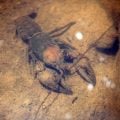How to Tie a Parachute Ant, Size 20
Producer: Tim Flagler
I believe ants are one of the more overlooked trout food sources, which is a shame. There have been numerous times in the summer and fall when a small ant fly, like this one, has absolutely saved the day for me. Larger ones will definitely work, but for whatever reason, size 20’s and 22’s, although somewhat difficult to see, really get the job done.
For a hook, I’m going to use a size 20 Lightning Strike DF1. The shank length is just right and the fine wire helps the fly to float longer without dressing. Begin by getting the hook firmly secured in the jaws of your tying vise.
For thread, I’ve loaded a bobbin with a spool of Veevus 10/0 in black. You can go even lighter if you feel like it. Get the thread started on the hook shank, leaving a little space behind the eye, and after taking a few wraps rearward, snip off the excess tag. Continue wrapping rearward to about the hook point, then forward to just past the midpoint of the hook shank.
White polypropylene floating yarn is used for the fly’s wing post. Snip a card-width segment free from the card. Split the segment in half lengthwise. Get hold of one end of one of the halves and lay it on top of the hook shank, above your tying thread. Use a pinch wrap to begin securing the yarn to the top of the shank. Without letting go of the rear portion of the yarn, lift it up and snip it off close. Take thread wraps forward to where you started wrapping.
Lift the remaining portion of the yarn up to vertical and give it a real good clockwise twist, as if you’re looking down on it. Fold the twisted yarn over, so it furls on itself. Secure the yarn to the hook shank, in front of the newly-formed post. Lift the excess portion of the yarn up and snip it off close. Continue taking thread wraps, both front and back, to cover the snipped off ends. Leave your tying thread at about the hook point.
Black Superfine dubbing is used to create the fly’s two body segments. A small pinch is all you need for the rear segment. Align the fibers parallel to your tying thread and use them to produce a very slender dubbing noodle, approximately an inch-and-a-half in length. Start taking wraps with the noodle to build up a bulbous, little abdomen on the fly. Don’t make it so big that it blocks the hook gap. Take thread wraps forward to in front of the furled wing post.
Here I’m going to use grizzly midge saddle hackle for the parachute, but use whatever you’ve got that’s nice and small. This feather measures between and an 18 and a 20, which is perfect. When you’re satisfied with the barbule length, pluck the feather free from the skin. With the shiny side of the feather facing you, strip off about a 1/2” of lower fibers from both sides of the stem. Flip the feather over and strip a 1/4” of fibers from only the lower side of the stem. I’ve got a little too much stem here so I’m going to trim it off.
With the dull side of the feather still facing you, lay the end of the stem on top of the hook shank, behind the eye, and take thread wraps to secure it. Wrap first to the base of the post then around both the post and the stem. Keep taking thread wraps up the post for about an 1/8” then wrap back down. Try to keep the wraps as smooth as possible. End with your tying thread a little ways back from the hook eye.
Pull another even smaller clump of black Superfine dubbing from the packet, and use it to create a slender 1” long noodle on your tying thread. Use that noodle to build up a front segment on the ant. End with your tying thread in front of the wing post on the near side of the hook.
Get hold of the hackle feather and start taking wraps with it. The dull side of the feather should face down. Continue taking touching wraps down the wing post with the feather. It’s ok to trap a few fibers as you go. When you reach the base of the post, use your tying thread to firmly anchor the feather to the post. Then, reach in with the tips of your tying scissors and snip the excess off close.
Pick up your whip finish tool and use it to do a 4 or 5 turn, vertical whip finish at the base of the post, seat the knot well and snip or cut your tying thread free. A drop of head cement, here Sally Hansen Hard as Nails, applied to the thread wraps at the base of the post will greatly increase the fly’s durability. The final step is to trim off the furled post. I like to keep the fibers fairly short so the fly doesn’t get too top heavy.
As small as this fly is, trout seem to have no trouble locating it on the water’s surface and will often move a fair distance to take it. The short white post is more so the angler can see the fly than it is to represent a wing on the ant.
How to Tie a Parachute Adams Size 22
How to Tie a Parachute Hendrickson











